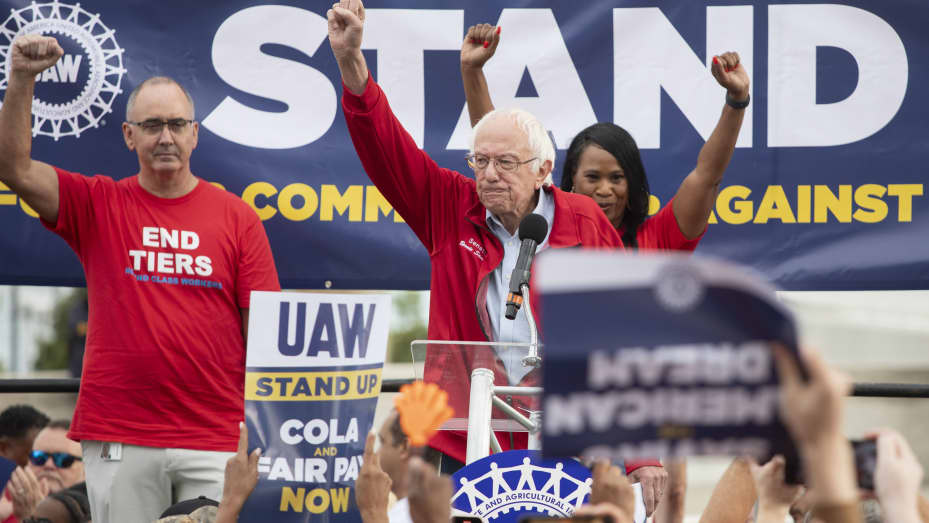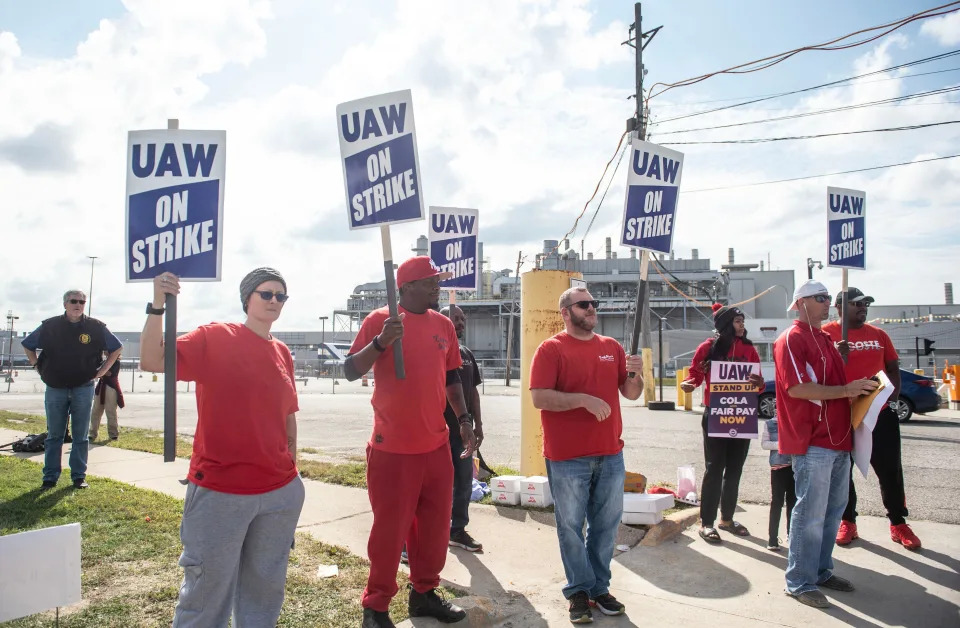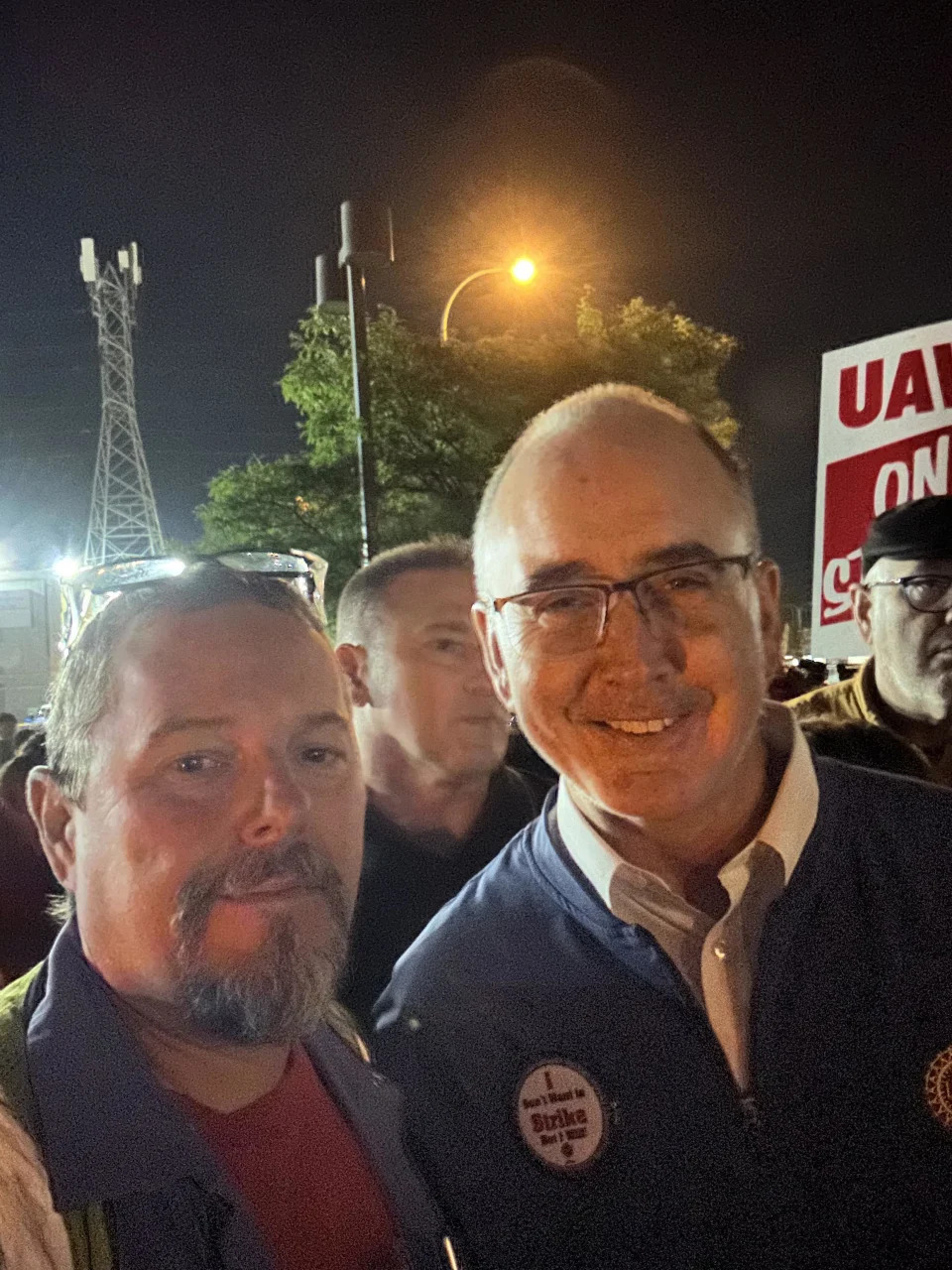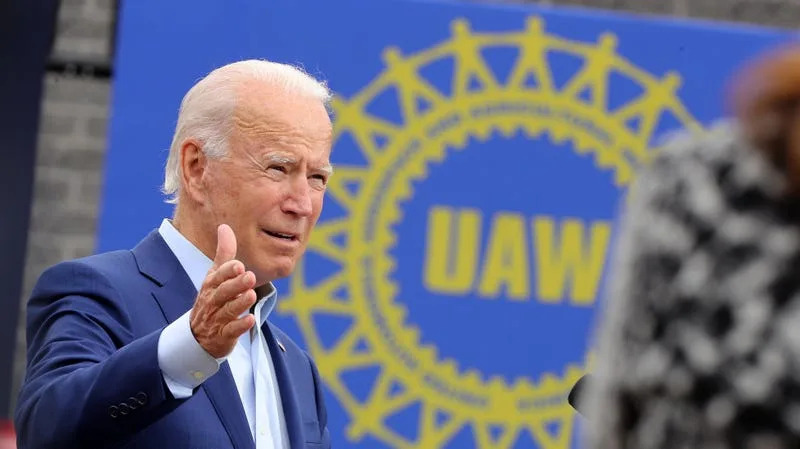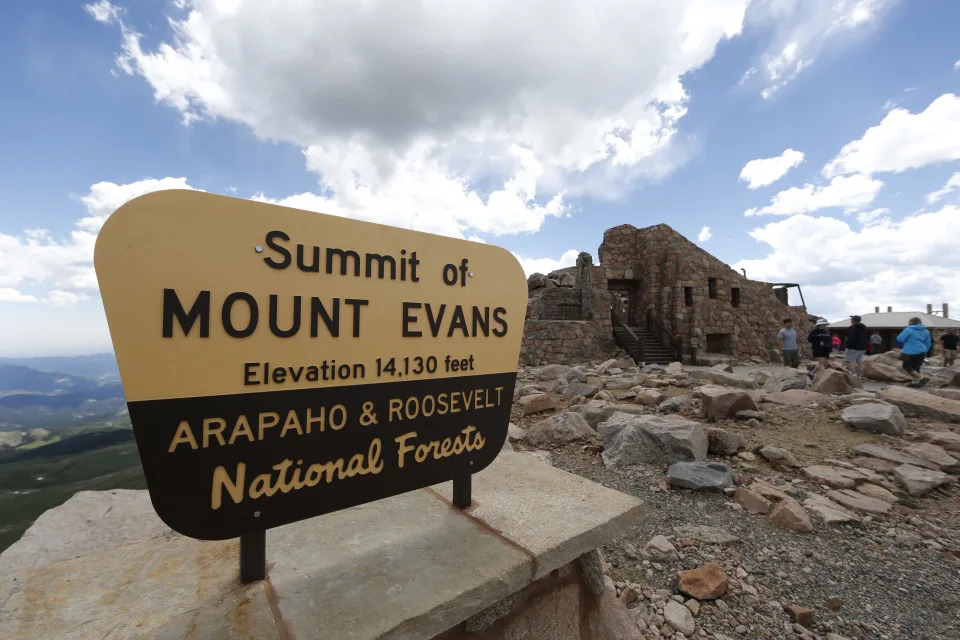Paige Hagy
Fri, September 15, 2023

Matthew Hatcher—AFP via Getty Images
As the United Auto Workers union faces off against Detroit’s Big Three automakers in a historic strike on Friday, the key demand is pay. Workers at Ford, General Motors, and Stellantis (formerly known as Fiat Chrysler) are demanding a 40% increase to make up for years of inflation. And to show the companies can afford to give their workers more, the union is highlighting the automakers’ exceptional generosity to a sliver of their workforce: their CEOs.
While some fear the impact that a long-lasting strike could have on the economy, with the Business Roundtable saying it is “deeply concerned,” UAW president Shawn Fain suggests it’s the top brass at the Big Three who have the most to lose.
“It’s not [that] we’ll wreck the economy. We’ll wreck their economy, the economy that only works for the billionaire class and not the working class,” Fain told CNN this week.
The UAW also shot down Ford CEO Jim Farley’s attempts to paint workers’ demands as unrealistic. After Farley unfavorably compared the union's pay demand to that of schoolteachers and firefighters, suggesting, using dubious figures, that a single autoworker could make “four, five, six times” a teacher’s salary, the UAW called out his hypocrisy by pointing to Farley’s own pay package.
“This man made $21 MILLION DOLLARS last year,” the UAW said in a post. With the median Ford employee making less than $75,000 in 2022, according to SEC filings, Farley took home the pay of 281 Ford workers.
Put another way, an hourly Ford employee would need to labor for seven working lifetimes to earn the same amount of money that Farley, between his base salary, bonus, stock options, and fringe benefits, took home in a single year.
The divide between Farley and his workforce isn’t unique—the disparity between the salaries of General Motors and Stellantis chief executives and their employees is even greater. The sky-high pay highlights a widening inequality between leaders and the rank and file, fueling workers’ suspicions that CEOs are increasingly out of touch with their employees.
A growing gap
At General Motors, the worker-to-boss disparity is even more extreme—GM CEO Mary Barra made 361 times her typical employee’s pay last year, bringing in $29 million while the median worker earned $80,000. Similarly, Stellantis CEO Carlos Tavares made the salary of 365 employees, earning $25 million (or 23.4 million euros) while the typical employee earned $68,000.
Ford and GM did not respond to Fortune’s request for comment. Stellantis declined to comment.
While workers contend with higher costs of living as inflation and interest rates rise but their paychecks remain the same, top CEOs’ pay continues to increase steadily—with barely any regard for how their companies perform. Record stock-market performance in 2021 drove CEOs’ pay up by 17% that year, according to research from executive compensation firm Equilar—but while stocks fell in 2022, CEO pay just kept rising, albeit by a smaller portion.
Just look at Tavares: The CEO of the company that makes Jeeps and Chevys saw his pay more than double from $12 million in 2020 to $23 million in 2022. And earlier this year, the nonprofit advocacy group As You Sow named Ford CEO Jim Farley one of its 100 most overpaid CEOs, decreeing that over $8 million of his $21 million pay package was "excess."
The inflation of the past three years is especially galling for autoworkers, who agreed to give up automatic cost-of-living increases in 2008 when two of the Big Three filed for bankruptcy and had to be bailed out by the federal government. Since then, workers’ inflation-adjusted income has fallen 19%, according to the Economic Policy Institute, a left-leaning think tank.
"The Big Three CEOs saw their pay increase by 40% over the last four years, while our pay only went up by 6%," Fain said at a news conference.
Fain, and the rank and file, are betting that the Big Three can shell out more. EPI predicts them to pull in more than $32 billion in additional profit just in the second half of this year.
This story was originally featured on Fortune.com
Will Daniel
Fri, September 15, 2023
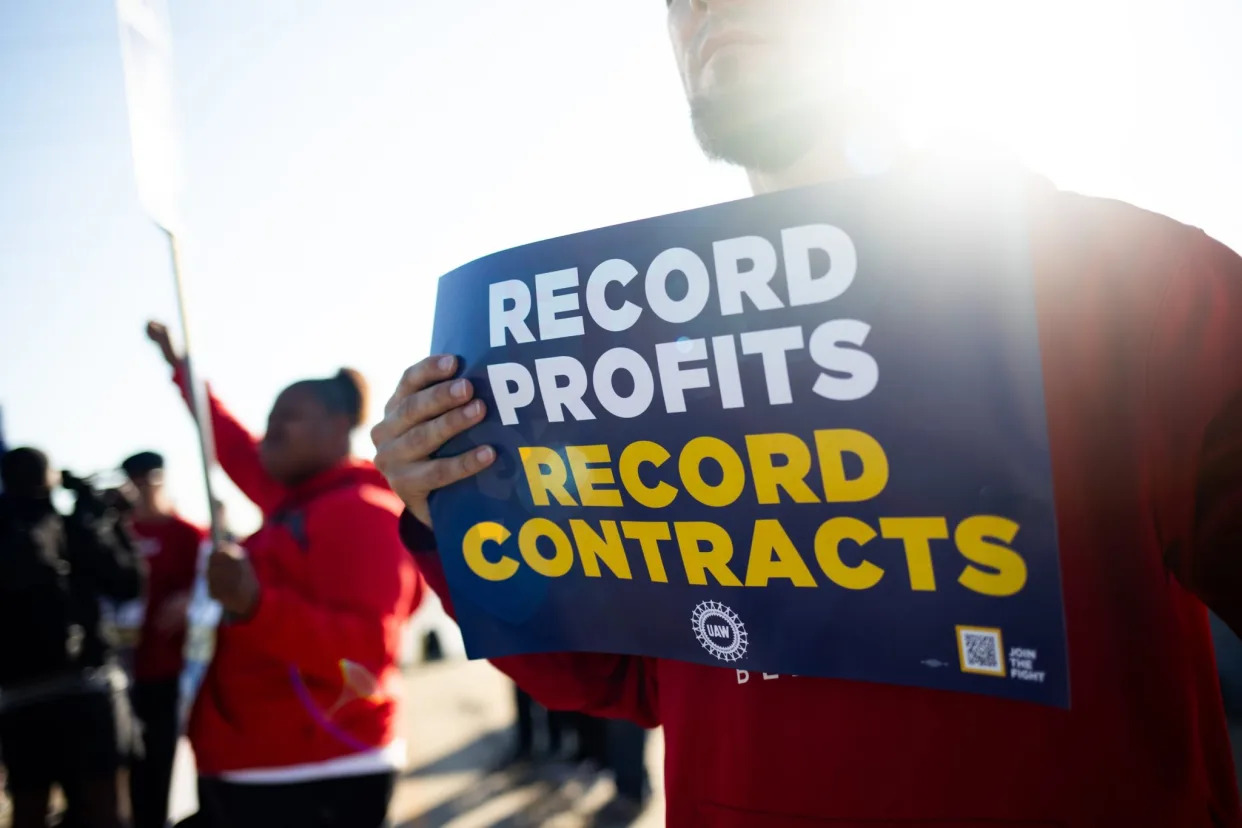
Emily Elconin/Bloomberg via Getty Images
Nearly 13,000 auto workers left their jobs at key factories for picket lines on Friday after union leaders failed to agree to a contract with Detroit’s Big Three automakers.
United Auto Workers leaders are asking for a 32-hour week for full-time pay, the restoration of traditional pensions, retiree medical benefits, and more. But perhaps most importantly, they’re looking for a significant pay raise for their members. Union leaders initially targeted a 46% pay bump, but have since dropped it to 36%.
The demands—which even the UAW's own president has labeled "audacious"—have led to criticism from the automakers. Ford CEO Jim Farley, who made nearly $21 million in total compensation last year, told CNBC Thursday before the strike that there is no way his company would be “sustainable” if it accepted the UAW’s salary demands, while clarifying that he is still hoping for a “historic deal.”
The gap between the automakers and the union remains large when it comes to salary, with GM and Ford both offering a 20% raise, while Stellantis, formerly Fiat Chrysler, has offered just 17.5%.
However, according to Harry Wilson, CEO of the corporate restructuring advisory firm MAEVA Group, the UAW’s latest mid-30% raise offer—which would be phased in over a four-year period—isn’t too far from what is “fair” after years of inflation.
“If you look at just the compounding of inflation from 2019 when the last agreement began through today—and even if you assume normalized inflation going forward, which I think is more likely than not—that ends up being 30% above where they are today,” he told CNBC Friday of UAW workers’ salaries.
Wilson, who served as a senior member of President Obama’s auto task force, which handled the bailouts of GM and Chrysler in 2009 after the Global Financial Crisis, argued that a 30% raise merely “allows workers to keep up with inflation.” He believes that automakers should come to the table and offer a larger salary increase to end the UAW strike, but forgo demands that have “bankrupted” their companies in the past, including the 32-hour workweek and retiree medical benefits. These issues, Wilson said, would be significant long-term strains on automakers’ bottom lines because they hinder worker productivity, risking “the long-term success and viability of automakers.”
Can automakers afford it?
When it comes to Farley’s claim that his company can’t afford the UAW’s proposed salary increase, analysts have pushed back.
According to a recent note from Morgan Stanley’s auto analyst Adam Jonas, Ford can afford the pay increases, but it would be challenging. Jonas explained that a 40% pay raise would equate to an additional $2.6 billion labor bill for the company. But given that Ford’s forecasted revenue for 2023 is $168 billion, that would only mean a shift from the company’s current expected “UAW labor bill” of 3.8% of revenues to a new labor bill that is 5.3% of revenues.
Jonas noted that although the increase in labor costs is “substantial,” Ford should be able to offset some of its labor expenses by raising vehicle prices as well as cutting costs in other areas, like research and development or capital expenditures.
“Are the headwinds material? Yes. But we think the labor inflation is well known and properly estimated. We believe the offsets are likely underestimated,” he wrote, arguing the UAW strike and contract negotiations will eventually create better “capital discipline” at Ford and GM.
Still, Wedbush tech analyst Dan Ives, who has taken to covering the automotive industry during its EV and autonomous driving transition, believes that the strike and the requests from the UAW are a “nightmare scenario” for automakers.
“In this crucial period of EV execution, model roll-outs, distribution, marketing, with EV competition rising across the board the timing could not be worse,” he wrote in a Friday note. “We spent time in Detroit a few weeks ago and sense a ‘very nervous time’ across the auto industry as there is a lot riding on these negotiations.”
This story was originally featured on Fortune.com
‘This man made $21 million last year’: Striking UAW blasts Ford CEO for suggesting they are greedy for demanding more than schoolteachers and firemen get
Christiaan Hetzner
Fri, September 15, 2023
The UAW blasted Jim Farley’s pay package after the Ford CEO accused it of driving the company toward bankruptcy by wanting factory workers to earn far more than other valued professions.
Speaking to CNBC on Thursday, Farley portrayed its demand for a 40% total wage hike over a four-year contract—or roughly 10% annually—as excessive and unfair to other hardworking Americans.
“Instead of making money and distributing $75,000 in profit sharing the last 10 years, we would have lost $15 billion and gone bankrupt by now. The average pay would be nearly $300,000 fully fringed for a four-day work week [per UAW employee],” he told the broadcaster.
“A full tenured schoolteacher in the U.S. makes $66,000, some of the military or firemen makes mid $50,000. This is four, five times, six times what they make.”
It’s unclear how Farley arrived at his figures as they would suggest factory line workers currently earn more than $210,000 in annual total compensation. Moreover, negotiations typically involve two parties deliberately putting forward maximalist demands knowing they will meet somewhere in the middle.
Ford could not be reached by Fortune for comment.
Farley subsequently sought to drive a wedge between his hourly workers and the union, implying the latter had little actual interest in the well-being of its members since it refused the company’s counteroffer.
“You want us to choose bankruptcy over supporting our workers?” he rhetorically asked the UAW.
Tug of war for public support
By casting the UAW as greedy, Farley is gambling he can win over the public—a key bargaining chip to prevail in a strike. Whichever side to first find itself perceived as the less reasonable typically ends up being the first to concede on key stumbling blocks.
The UAW, however, was quick to respond to Farley’s emotional appeal, putting the boot into the Ford boss personally in a bid to portray him as a hypocrite.
“This man made $21 MILLION last year,” the union posted on social media in a bid to regain the moral high ground.
Nonprofit advocacy group As You Sow seemed to agree. According to its estimates, there is a sizable discrepancy between the performance of Ford and GM when compared to larger foreign peers and their CEOs' generous pay packages.

CEO pay packages in the auto industry
Fighting to recoup a considerable loss in purchasing power during the past two years of high inflation, workers point to the trio’s record profits—a combined $21 billion in the first six months of this year—as proof that shareholders have helped themselves to more than a fair share of the pie.
On Thursday night, UAW boss Shawn Fain announced rolling strikes at Detroit’s General Motors, Ford, and Chrysler parent Stellantis.
“Tonight for the first time in our history, we will strike all three of the Big Three at once,” he said.
Pressure to upstage the Teamsters' success with UPS
About 13,000 workers picketed the GM Wentzville plant in Missouri, Stellantis’ Toledo facility, and Ford’s Michigan Assembly in Wayne. All three focus on higher-margin models like pickup trucks and SUVs that are critical to the companies’ bottom line.
Shop floor workers elsewhere will continue to build cars under an expired contract until they are called upon to down tools and walk out.
“This strategy will keep the companies guessing. It will give our national negotiators maximum leverage and flexibility in bargaining,” Fain said. “And if we need to go all out, we will—everything is on the table.”
In a statement on Thursday, Ford warned union workers that striking for better pay and conditions will hurt them financially.
“Our hourly employees would take home nearly 60% less on average with UAW strike pay than they would from working. And without vehicles in production, the profit-sharing checks that UAW workers could expect to receive early next year will also be decimated by a significant strike.”
The pressure is on Fain to win a pay hike at least as lucrative as the Teamsters'. The latter made headlines with their recent UPS deal that saw interest in applying to become a delivery driver soar. All that rival union needed to do was simply authorize a strike in order to gain enough leverage to hammer out a deal it claimed was worth $30 billion—following through on its threat proved to be unnecessary.
But not every union has been as successful in extracting concessions. The Writers’ Guild of America and the Screen Actors Guild have been on strike for months to negotiate better terms with Hollywood studios with nothing to show for it.
“The money is there, the cause is righteous, the world is watching, and the UAW is ready to stand up," union boss Fain said. "This is our defining moment.”
This story was originally featured on Fortune.com




